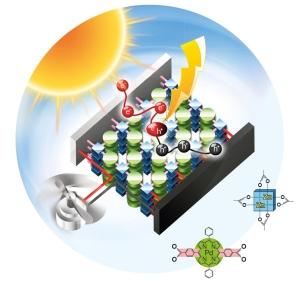First solar cell made of highly ordered molecular frameworks

Organic solar cells made of metal-organic frameworks are highly efficient in producing charge carriers. Figure: Woell/KIT
“We have opened the door to a new room,” says Professor Christof Wöll, Director of KIT Institute of Functional Interfaces (IFG). “This new application of metal-organic framework compounds is the beginning only. The end of this development line is far from being reached,” the physicist emphasizes.
Metal-organic frameworks, briefly called MOFs, consist of two basic elements, metal node points and organic molecules, which are assembled to form microporous, crystalline materials. For about a decade, MOFs have been attracting considerable interest of researchers, because their functionality can be adjusted by varying the components. “A number of properties of the material can be changed,” Wöll explains. So far, more than 20,000 different MOF types have been developed and used mostly for the storage or separation of gases.
The team of scientists under the direction of KIT has now produced MOFs based on porphyrines. These porphyrine-based MOFs have highly interesting photophysical properties: Apart from a high efficiency in producing charge carriers, a high mobility of the latter is observed. Computations made by the group of Professor Thomas Heine from Jacobs University Bremen, which is also involved in the project, suggest that the excellent properties of the solar cell result from an additional mechanism – the formation of indirect band gaps – that plays an important role in photovoltaics.
Nature uses porphyrines as universal molecules e.g. in hemoglobin and chlorophyll, where these organic dyes convert light into chemical energy. A metal-organic solar cell produced on the basis of this novel porphyrine-MOF is now presented by the researchers in the journal Angewandte Chemie (Applied Chemistry).
The contribution is entitled “Photoinduzierte Erzeugung von Ladungsträgern in epitaktischen MOF-Dünnschichten: hohe Leistung aufgrund einer indirekten elektronischen Bandlücke?” (photo-induced generation of charge carriers in epitactic MOF-thin layers: high efficiency resulting from an indirect electronic band gap?).
“The clou is that we just need a single organic molecule in the solar cell,” Wöll says. The researchers expect that the photovoltaic capacity of the material may be increased considerably in the future by filling the pores in the crystalline lattice structure with molecules that can release and take up electric charges.
By means of a process developed at KIT, the crystalline frameworks grow in layers on a transparent, conductive carrier surface and form a homogeneous thin film, so-called SURMOFs. “The SURMOF process is suited in principle for a continuous manufacturing process and also allows for the coating of larger plastic carrier surfaces,” Wöll says. Thanks to their mechanical properties, MOF thin films of a few hundred nanometers in thickness can be used for flexible solar cells or for the coating of clothing material or deformable components. While the demand for technical systems converting sunlight into electricity is increasing, organic materials represent a highly interesting alternative to silicon that has to be processed at high costs before it can be used for the photoactive layer of a solar cell.
###
Jinxuan Liu, Wencai Zhou, Jianxi Liu, Ian Howard, Goran Kilibarda, Sabine Schlabach, Damien Coupry, Matthew Addicoat, Satoru Yoneda, Yusuke Tsutsui, Tsuneaki Sakurai, Shu Seki, Zhengbang Wang, Peter Lindemann, Engelbert Redel, Thomas Heine, and Christof Wöll: Photoinduzierte Erzeugung von Ladungsträgern in epitaktischen MOF-Dünnschichten: hohe Leistung aufgrund einer indirekten elektronischen Bandlücke?, Angewandte Chemie, Ausgabe 25/2015. German edition: DOI: 10.1002/ange.201501862, International edition: DOI: 10.1002/anie.201501862
http://onlinelibrary.
Karlsruhe Institute of Technology (KIT) is a public corporation pursuing the tasks of a Baden-Wuerttemberg state university and of a national research center of the Helmholtz Association. The KIT mission combines the three core tasks of research, higher education, and innovation. With about 9,400 employees and 24,500 students, KIT is one of the big institutions of research and higher education in natural sciences and engineering in Europe.
Since 2010, the KIT has been certified as a family-friendly university.
Media Contact
All latest news from the category: Information Technology
Here you can find a summary of innovations in the fields of information and data processing and up-to-date developments on IT equipment and hardware.
This area covers topics such as IT services, IT architectures, IT management and telecommunications.
Newest articles

Combatting disruptive ‘noise’ in quantum communication
In a significant milestone for quantum communication technology, an experiment has demonstrated how networks can be leveraged to combat disruptive ‘noise’ in quantum communications. The international effort led by researchers…

Stretchable quantum dot display
Intrinsically stretchable quantum dot-based light-emitting diodes achieved record-breaking performance. A team of South Korean scientists led by Professor KIM Dae-Hyeong of the Center for Nanoparticle Research within the Institute for…

Internet can achieve quantum speed with light saved as sound
Researchers at the University of Copenhagen’s Niels Bohr Institute have developed a new way to create quantum memory: A small drum can store data sent with light in its sonic…





















